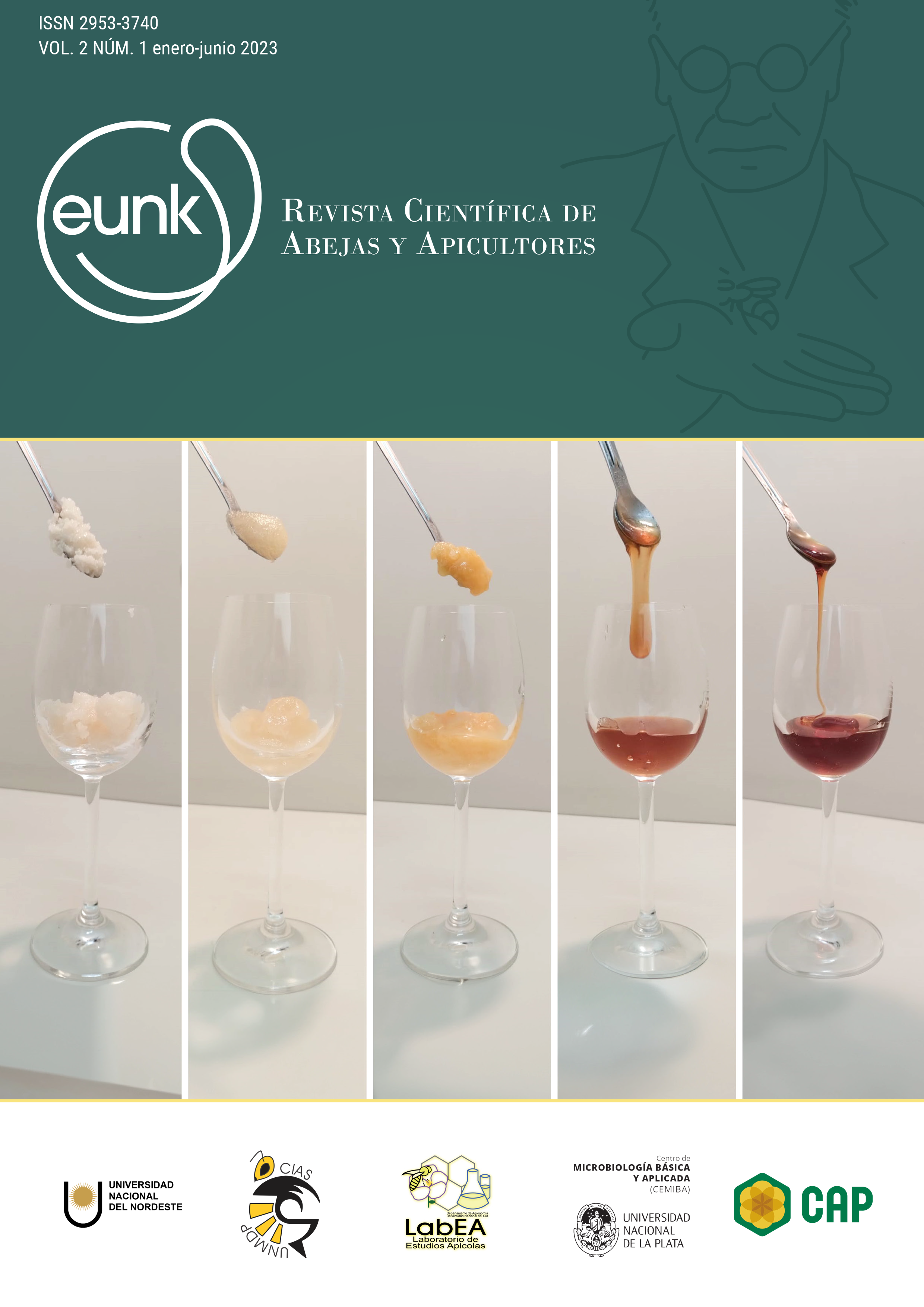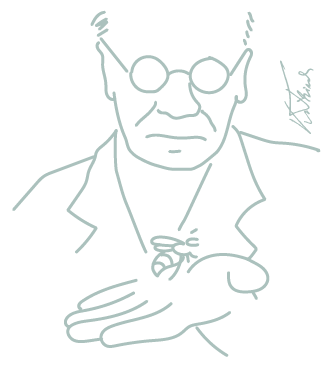Las abejas melíferas (Apis mellifera) como biomonitores de contaminación ambiental mediada por metales pesados
DOI:
https://doi.org/10.52559/eunk.v2i1.31Palabras clave:
abejas, polen, miel, biomonitores, metales pesadosResumen
En este trabajo se estudió el uso de colonias de abejas (Apis mellifera) como biomonitores de contaminación ambiental por metales pesados. Para ello se evaluó la concentración de Cd (cadmio), Cr (cromo), Ni (níquel), Pb (plomo) y Zn (cinc) en abejas, polen y miel colectadas en apiarios ubicados en tres zonas con diferentes fuentes de contaminación. Los muestreos para la determinación de metales pesados se realizaron en cada apiario una vez al mes, durante doce meses. Las muestras de abejas y polen fueron procesadas mediante digestión ácida y las soluciones resultantes fueron analizadas mediante espectrofotometría de absorción atómica. En tanto que las muestras de miel se procesaron por digestión en microondas y la detección fue realizada en espectrómetro de fluorescencia de rayos X por reflexión total. Las concentraciones de cada uno de los metales fueron determinadas en relación al peso seco de las muestras. Los datos obtenidos indicaron que los cinco metales pudieron ser detectados en abeja y polen y solo pudo ser determinado el cinc en las muestras de miel. La matriz que mejor resulto como biomonitor de contaminación por metales pesados resulto ser la abeja.
Descargas
Citas
Aghamirlou, H. M., Khadem, M., Rahmani, A., Sadeghian, M., Mahvi, A.H., Akbarzadeh, A., Nazmara, S. (2015) Heavy metals determination in honey samples using inductively coupled plasma-optical emission spectrometry. Journal of Environmental Health Science & Engineering 13, 39. DOI: https://doi.org/10.1186/s40201-015-0189-8
Amdam Gro, V., Simões Zilá L. P., Hagen, A., Norberg, K., Schrøderc, K., Mikkelsenc, Ø., Kirkwoodd, T. B.L., Omholta S. W. (2004) Hormonal control of the yolk precursor vitellogenin regulates immune func-tion and longevity in honeybees. Experimental Gerontology 39, 767-773. DOI: https://doi.org/10.1016/j.exger.2004.02.010
Anderson, M.J., Gorley, R.N., Clarke, K.R. (2008). PERMANOVA+ for PRIMER: Guide to Software and Sta-tistical Methods. PRIMER-E, Plymouth, UK.
Borsuk, G., Sulborska, A., Stawiarz, E., Olszewski, K., Wiącek, D., Ramzi, N., Nawrocka, A., Jędryczka, M. (2021). Capacity of honeybees to remove heavy metals from nectar and excrete the contami-nants from their bodies. Apidologie 52:1098–1111. DOI: https://doi.org/10.1007/s13592-021-00890-6
Clarke, K.R., Gorley, R.N. (2006). PRIMER V6: User Manual/Tutorial. PRIMER-E, Plymouth, UK.
Clarke, K.R., Warwick, R.M. (2001). Change in marine communities: an approach to statistical analysis and interpretation, 2nd edn. PRIMER-E, Plymouth, UK.
Conti, M., Astolfi, M., Mele, G., Ristorini, M., Vitiello, G., Massimi, L., Canepari, S., Finoia, M. (2022) Per-formance of bees and beehive products as indicators of elemental tracers of atmospheric pollu-tion in sites of the Rome province (Italy). Ecological Indicators 140, 109061. DOI: https://doi.org/10.1016/j.ecolind.2022.109061
Bogdanov, S., A. Imdorf, J. Charriere, P. Fluri, Kilchenmann, V. (2003). The contaminants of the bee colo-ny. Bulgarian Journal of Veterinary Medicine, 6 (2), 59-70
Bogdanov, S. (2006). Contaminants of bee products. Apidologie, 37 (1), 1-18. DOI: https://doi.org/10.1051/apido:2005043
Bogdanov, S., Haldimann, M., Luginbühl, W., Gallmann P. (2007) Minerals in honey: environmental, geo-graphical and botanical aspects. Journal of Apicultural Research and Bee World 46(4): 269–275. DOI: https://doi.org/10.1080/00218839.2007.11101407
Celli, G. & Maccagnani B. (2003). Honey bees as biondicators of environmental pulltion. Bulletin of Insec-tology, 56, 137-139.
Codex Alimentaris Commission. Standard for Honey, Ref. no.CL 1993/14, SH, Codex Alimentarius Commis-sion. F.A.O./W.H.O. Rome, 1993.
Devillers, J. & Pharm-Delegue, M.H. (editors). (2002). Honey bees: Estimating the Environmental Impact of chemicals. Taylor & Francis, London and New York. DOI: https://doi.org/10.1201/9780203218655
Di, N., Hladun, K.R., Zhang, K., Liu, T.X. & Trumble, J.T. (2016). Laboratory bioassays on the impact of cad-mium, copper and lead on the development and survival of honeybee (Apis mellifera L.) larvae and foragers. Chemosphere, 152, 530-538. DOI: https://doi.org/10.1016/j.chemosphere.2016.03.033
Diels, L., Van Der Lelie, N., Bastiaens, L. (2002) New developments in treatment of heavy metal contami-nated soils. Re/Views in Environmental Science and Bio/Technology 1, 75–82. DOI: https://doi.org/10.1023/A:1015188708612
Enrich,C., Boeykens, N. Caracciolo, G. Custo & Vazquez C. (2007). Honey characterization by total reflec-tion x-ray fluorescence: evaluation of environmental quality and risk for the human health. X-ray Spectrometry X-Ray Spectrom, 36, 215–220. DOI: https://doi.org/10.1002/xrs.944
Falco, G., Gomez-Catalan, C., Llobet, J.M., Domingo, J.L. (2003) Contribution of medicinal plants to the dietary intake of various toxic elements in Catalonia, Spain. Trace Element Electrolyte, 20, 120-124. DOI: https://doi.org/10.5414/TEP20120
García Rico, L., Robles Burgueño, M. & Valenzuela Soto, E. M. (1999). Las metalotioneínas y su relación con la toxicidad del cadmio en los mamíferos. Revista Internacional de Contaminación Ambiental. 15 (2), 113-120.
Hladun, K.R., Parker, D.R., Trumble, J.T. (2015). Cadmium, copper, and lead accumulation and bioconcen-tration in the vegetative and reproductive organs of Raphanus sativus: implications for plant per-formance and pollination. Journal of Chemical Ecology 41, 368-395. DOI: https://doi.org/10.1007/s10886-015-0569-7
Hoffel, I., 1985. Heavy metals in bees and bee products. Apidologie 16, 196e197, 141.
Kumpiene, J., Lagerkvist, A., Maurice, C. (2008) Stabilization of As, Cr, Cu, Pb and Zn in soil using amend-ments - A review. Waste Management, 28 (1), 215-225. DOI: https://doi.org/10.1016/j.wasman.2006.12.012
Leita, L., Muhlbachova, G., Cesco, S., Barbattini ,R., Mondini, C. (1996) Investigation of the use of honey-bees and honeybee products to assess heavy metals contamination. Environmental Monitoring and Assessment 43, 1–9. DOI: https://doi.org/10.1007/BF00399566
Leung, A., Duzguren-Aydin, N., Cheung, KC. & Wong, M. (2008). Heavy metal concentrations of surface dust from e-waste recycling and its human health implications in Southeast China. environmental science and technology. 42(7), 2674-2680. DOI: https://doi.org/10.1021/es071873x
Markert, B., Wünschmann, S., (2011). bioindicators and biomonitors: Use of organisms to observe the influence of chemicals on the environment. In: Schroder, ¨ P., Collins, C.D. (Eds.), Organic Xenobi-otics and Plants. Plant Ecophysiology, 8, 217–236. DOI: https://doi.org/10.1007/978-90-481-9852-8_10
Matuszewska, E., Klupczynska, A., Maciołek, K., Kokot, Z. J., & Matysiak, J. (2021). Multielemental Analysis of Bee Pollen, Propolis, and Royal Jelly Collected in West-Central Poland. Molecules 26(9), 2415. DOI: https://doi.org/10.3390/molecules26092415
Meindl, G.A., Ashman, T.L. (2013) The effects of aluminum and nickel in nectar on the foraging behavior of bumblebees. Environmental pollution, 177,78-81. DOI: https://doi.org/10.1016/j.envpol.2013.02.017
Morgano, M.A., Teixeira Martins, M.C., Rabonato, L.C., Milani, R.F., Yotsuyanagi, K., Rodriguez-Amaya, D.B. (2010). Inorganic contaminants in bee pollen from southeastern Brazil. Journal of Agricultural and Food Chemistry, 58(11), 6876-83. DOI: https://doi.org/10.1021/jf100433p
Nascimento, A.S., Chambó, E.D., Oliveira, D.J., Andrade, B.R., Bonsucesso, J.S., Carvalho, C. (2018). Honey from Stingless Bee as Indicator of Contamination with Metals. Sociobiology 65(4): 727-736. DOI: https://doi.org/10.13102/sociobiology.v65i4.3394
Oroian, M., Prisacaru, A., Hretcanu, E.C., Stroe, S.G., Leahu, A. & Buculei, A. (2016) Heavy Metals profile in honey as a potential indicator of botanical and geographical origin. International Journal of Food Properties, 19:1825-1836. DOI: https://doi.org/10.1080/10942912.2015.1107578
Padilla Alvarez, F. (2009). El envejecimiento de las abejas: abejas de verano y abejas de invierno. El col-menar 93, 40-51.
Perugini, M., Manera, M., Grotta, L., Abete, M.C., Tarasco, R. & Amorena, M. (2011). Heavy metal (Hg, Cr, Cd, and Pb) contamination in urban areas and wildlife reserves: honeybees as bioindicators. Bio-logical Trace Element Research, 140, 170-176. DOI: https://doi.org/10.1007/s12011-010-8688-z
Porrini, C., Sabatini A., Girotti S., Ghini S., Medrzycki P., Grillenzoni F., Bortolotti L., Gattavecchia E. & Celli G.. (2003). Honey bees and bee products as monitors of the environmental contamination. Apiac-ta 38, 63- 70.
Salihaj, M., Bani, A. (2017) The nickel content in honey derived from serpentine and non-serpentine are-as of Kosovo. Albanian journal of agricultural science, 557-563.
Salis, S. (2008). Stima dell’impatto ambientale di attivita’ minerarie ed industriali attraverso la determina-zione etaas di metalli in tracce in api e matrici d’alveare. Tesis Doctoral. Universita degli Studi di Sassari. (En italiano).
Temamogullar, F, Yazar, S., Baskaya, R. (2012) Determination of some heavy metals in honey. Eurasian journal veterinary sciences, 28(1), 38-40.
Wang, Y.M., Chen, T.C., Yeh, K.J., Shue, M.F. (2001) Stabilization of an elevated heavy metal contaminat-ed site. Journal of Hazardous Materials, 88 (1), 63-74. DOI: https://doi.org/10.1016/S0304-3894(01)00289-8
Wakgari, M. & Yigezu G. (2021) Honeybee keeping constraints and future prospects, Cogent Food & Agri-culture, 7(1), 1-31. DOI: https://doi.org/10.1080/23311932.2021.1872192
Yazgan, S., Horn, H., Isengard, H.D. (2006) Honey as bio indicator by screening the heavy metal content of the environment. Deutsche Lebensmittel-Rundschau, 102, 192.
Publicado
Cómo citar
Licencia
Derechos de autor 2023 Manuel Cecchi

Esta obra está bajo una licencia internacional Creative Commons Atribución 4.0.
Los autores/as que publiquen en esta revista aceptan las siguientes condiciones:
- Los autores/as conservan los derechos de autor y ceden a la revista el derecho de la primera publicación, con el trabajo registrado con la licencia de atribución de Creative Commons 4.0, que permite a terceros utilizar lo publicado siempre que mencionen la autoría del trabajo y a la primera publicación en esta revista.
- Los autores/as pueden realizar otros acuerdos contractuales independientes y adicionales para la distribución no exclusiva de la versión del artículo publicado en esta revista (p. ej., incluirlo en un repositorio institucional o publicarlo en un libro) siempre que indiquen claramente que el trabajo se publicó por primera vez en esta revista.
- Se permite y recomienda a los autores/as a compartir su trabajo en línea (por ejemplo: en repositorios institucionales o páginas web personales) antes y durante el proceso de envío del manuscrito, ya que puede conducir a intercambios productivos, a una mayor y más rápida citación del trabajo publicado.
Datos de los fondos
-
Consejo Nacional de Investigaciones Científicas y Técnicas
Números de la subvención PIP 0804 -
Agencia Nacional de Promoción Científica y Tecnológica
Números de la subvención PICT 1625








